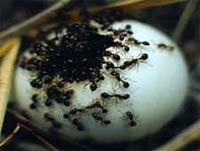
THE DEMISE OF BIRD EGGS
By Bob Jamison
High protein quality of bird eggs have been known for centuries. Long ago ancient Indians collected many kinds of bird eggs from islands and shores of inland bays and estuaries. They ate them raw or boiled them for a later snack. These eggs were mostly sea gull eggs but also were eggs from huge flocks of wading bird that nest in trees and bushes. All of which were a choice morsel for food. Included in these flocks of birds were herons, egrets, ibis and eggs of countless ground nesting birds.
One of the more recent plagues in our area is fire ants. An experiment by a wildlife biologist in south Louisiana created two huge predator proof pens about two acres in size. In one pen he prepared the native land with Andro fire ant killer. The second pen had none. In these pens were placed nesting pairs of Bob White Quail. Just only two hatches in the pen without the fire ant killer were successful. Others had problems when the exit cracking in the egg happened it was like calling all ants and the baby bird was history. The treated pen had remarkable positive results in hatching and raising baby quail.
Fire ants also make a significant detrimental change in small animal development such as cotton tail rabbits and others. However, new born calves have been known to be killed while lying in or near a fire ant bed.
Birds of many species actually have no remorse of landing on or near a bird nest to feast on eggs or even the young baby birds. Possibly the worst of these is the common crow. Raccoons also rank among the top as a predator. Some of these birds include hawks, owls and many types of black birds but especially grackles. There are reports that blame the decline of the red headed woodpecker on owl predations. The benefit of many of these predators would include a substantial diet of mice, rats and snakes.
In our area there a many kinds of snakes. Most of our snakes are of the non poisonous variety leaving only four that are dangerous. These are the rattlesnakes, copperheads, coral snakes and the cotton mouth moccasin. Many folks are confused with the multitudes of water snakes in the moccasin family with the only poisonous one is the cotton mouth. Other than this, the others are quite harmless. Of course they will be quite quick to bite an intruder but these bites are overwhelmingly insignificant, medically speaking.
One exception is understandable fright mainly caused from the lack of understanding.
However, the most significant predator of nest eggs is the notorious rat snake (commonly known as the chicken snake). They have a beautiful light and dark brown color patch work on their skin and seldom initiate a biting attack. Many builders of wood duck nest boxes have examined the boxes after the ducks start laying eggs only to find one or more of these snakes inside the nest. If so, a quick examination will often indicate several lumps in the snake’s body that are eggs it has swallowed.
The wood duck nest boxes are very successful in raising wood ducks. But the first rule is to make the box predator proof. This can be done with umbrella like shields below the box or metal stove pipe around the pole. PVC pipe also can be used around the pole but never shorter than four feet long. Extra precaution for pipe (stove or pvc) would be painted with heavy axel grease. This grease should be replaced periodically.
Therefore, if it is your desire to extricate a chicken snake from your duck nesting box or bird house, please do so with some care as it will bite at any violent provocation. In the unlikely event this happens, it is suggested that you should not jerk away from the bite but hold the snake behind the head until he releases the bite. Otherwise the snake might leave some of his tiny teeth in the cut and cause some discomfort. Simple medication is in order. However, this is in no way a substitute for professional medical attention if needed.